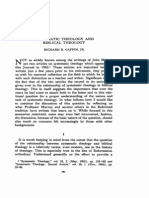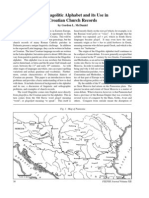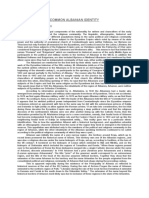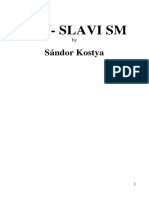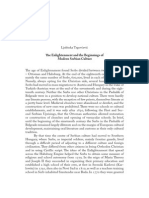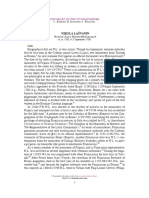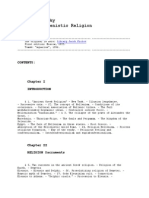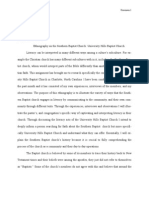Sremski Karlovci
Sremski Karlovci
Uploaded by
kispalerdoszoliCopyright:
Available Formats
Sremski Karlovci
Sremski Karlovci
Uploaded by
kispalerdoszoliOriginal Title
Copyright
Available Formats
Share this document
Did you find this document useful?
Is this content inappropriate?
Copyright:
Available Formats
Sremski Karlovci
Sremski Karlovci
Uploaded by
kispalerdoszoliCopyright:
Available Formats
Archives in Sremski Karlovci
Following the debacle of the Turkish forces at Vienna in 1683, the army of the West-European Alliance (Austria, Poland and Venetia) continued to drive the Turks out of the Balkan region of Podunavlje. During the Turkish counterattack of 1689/1690, it was driven back to the north on main direction Skopje-Belgrade, across the Sava and the Danube. Around 37000 Serbian families crossed the rivers with the allied forces. Those were the families which took part in the war on the side of Austria, either by staging an The seal of the Grammar armed uprising or in some other manner. Austrian School in Karlovci authorities regrouped them on the Croatia-SlavonijaHungary-Erdelj stretch. Serbs received privileges from the Roman-German Emperor Leopold I, which guaranteed them national and religious singularity and certain rights and freedoms in the Habsburg Monarchy. The key person in these processes was the Patriarch of Pec, Arsenije III Carnojevic. The same Emperor approved of him as of the head of the newly established Orthodox Church in the Monarchy in 1695. Carnojevic had the title of the Patriarch, which was not to be handed down by succession to his successors, the Metropolitans, until this right was secured on the May Assembly of Serbian people in Karlovci in 1848.
Emperor Leopold I approves of Arsenije III Carnojevic as of the Serbian Archbishop and of the seven bishops, whom he appointed in certain eparchies
In this little town in Srem on the river Danube, more known for the peace treaty signed there among the West-European Allies and Turkey in 1699, with many monasteries on Fruska Gora in the hinterland, the seat of the Serbian Orthodox Church was established in 1713. It got its most famous name by the name of the town the Metropolitanate of Karlovci. Serbs, Romanians, Tzintzars and other Orthodox subjects of the Habsburg Monarchy were under its spiritual leadership. After withdrawing of Romanians from the Metropolitanate of Karlovci in 1864, freeing of the Balkan people from the Turkish government and the dissolution of the Austro-Hungarian Monarchy in 1918, a new political and clerical organization was carried out in the newly independent countries. The Metropolinate of Karlovci merged with the autocephalous Serbian Orthodox Church in 1920 and it was transformed into the Patriarchate of Karlovci, with its seat in Belgrade. It made significant to the community, one of which was the Metropiltanate and the Patriarchate Archives in Sremski Karlovci.
(Pec), December 21, 1713. Sindjelija (order) of appointment of Mojsije Stanojevic for Bishop of Vrsac, issued by the Patriarch of Pec Mojsije Rajovic (detail)
The creation of the Archives is related to the Great Migration of the Serbs of 1690. That is when a part of the Serbian hierarchy and people brought some books, sacral inventory, Charters of the Serbian medieval rulers, sindjelijas (orders), berats (Sultans Charters) and other documents from the Balkan part of the Ottoman Empire to the Habsburg Monarchy. This documentation core was further extended by the correspondence that Patriarch Arsenije III and his successors had with secular, ecclesiastic and military institutions and individuals in the Habsburg Monarchy, Serbia, Russia and other countries, as representatives of state, church and school autonomy, or as private individuals. During the Second World War, the Archives were closed by German and Ustasha authorities and partly damaged. At the request of the Serbian Academy of
2/3
Sciences, Holy Sinod of Bishops of the Serbian Orthodox Church gave ,, the Metropolinates and Consistory in Sremski Karlovci for keeping and definite organizing, for their use for scholarly purposes on 4 July, 1949. The Academy procured financial means, staff and fulfilled the conditions for making this possible. It also secured the return of the 81st Charter from Vienna and placed the documents of the Archives of the Magistrate of Karlovci and Karlovci Grammar School, which were kept in inadequate and insecure places, in the Archives of Karlovci. It received some of the documents and sources as gifts from the citizens, it bought some and it microfilmed most of the documents of the Dalmatian Eparchy found in the Historic Archives of Zadar. The archival sources gathered in such manner in the Archives of Serbian Academy of Arts and Sciences in Karlovci chronologically date back from the mid sixteenth century until the seventies of the twentieth century, with references to farther past. They were written by people of different professions, in Serbian (and its different variants), German, Latin, Russian-Slovene, Hungarian, Italian, Greek, Romanian and other European languages. Regarding the content, these are petitions, appeals, reports, memoranda, protocols, contracts, testaments, correspondence, censuses etc. The documents are still being sorted out, put into protective boxes, preserved and restored from moist and other damages. For the time being, it is classified into forty-four funds and ten minor collections. The Archives has almost three million documents today. For most of them there are original or afterwards made registries, regestas, card files of individuals or summary catalogues. All in all, these documents are exceptional sources for political, cultural and economic history of the Serbian people in the Habsburg Monarchy, especially regarding church and religious life; schools, education, literature, art and various relations of Serbs with different Euro-Asian people. Ilarion and Dimitrije Ruvarac, Radoslav M. Grujuc, Mita Kostic, Dejan Medakovic, Vasilije Krestic, Slavko Gavrilovic, Nikola Gavrilovic are some of the great researchers who wrote their books, studies and articles based on the sources of the Archives or who published it in magazines and thematic collections of papers.
3/3
You might also like
- Planting Missional Churches - Stetzer - and - ImDocument3 pagesPlanting Missional Churches - Stetzer - and - ImWebLubango LubangoNo ratings yet
- Gaffin, Systematic Theology and Biblical TheologyDocument20 pagesGaffin, Systematic Theology and Biblical Theologytheoarticles100% (2)
- Revelations of Byzantium: The Monasteries and Painted Churches of Northern MoldaviaFrom EverandRevelations of Byzantium: The Monasteries and Painted Churches of Northern MoldaviaNo ratings yet
- David Marshall Lang-1966-Landmarks in Georgian LiteratureDocument34 pagesDavid Marshall Lang-1966-Landmarks in Georgian LiteratureLemon BarfNo ratings yet
- Byzantine NomocanonsDocument3 pagesByzantine NomocanonsMarina MiloševićNo ratings yet
- Obata Toshishiro - Naked BladeDocument127 pagesObata Toshishiro - Naked Bladekispalerdoszoli100% (4)
- How The LDS Church Fooled The World On The Origins of Its Racial PoliciesDocument11 pagesHow The LDS Church Fooled The World On The Origins of Its Racial PoliciesTruthIsReasonNo ratings yet
- INSTITUTI - OF - HISTORY - ALI - HADRI - PRISHTIN - Profesor Iljaz REXHADocument79 pagesINSTITUTI - OF - HISTORY - ALI - HADRI - PRISHTIN - Profesor Iljaz REXHAMarcus LeroumainNo ratings yet
- Estate Structure and Development of The Topusko (Toplica) Abbey. A Case Study of A Medieval Cistercian MonasteryDocument18 pagesEstate Structure and Development of The Topusko (Toplica) Abbey. A Case Study of A Medieval Cistercian MonasterybaredineNo ratings yet
- A X I N I A D Z U R o V A The Messages of CyrillicDocument32 pagesA X I N I A D Z U R o V A The Messages of CyrillicLovely Butterfly100% (1)
- The Armenians of Cyprus (PIO Booklet - English, 2016 Edition)Document40 pagesThe Armenians of Cyprus (PIO Booklet - English, 2016 Edition)Alexander-Michael HadjilyraNo ratings yet
- The Sources and Resources of The Carpathian Byzantine Liturgical Tradition in The Mukačevo EparchyDocument16 pagesThe Sources and Resources of The Carpathian Byzantine Liturgical Tradition in The Mukačevo EparchyHistorica VariaNo ratings yet
- Hungaria and Pannonia PDFDocument17 pagesHungaria and Pannonia PDFAnonymous 7isTmailHuseNo ratings yet
- Alfabetul GlagoliticDocument8 pagesAlfabetul GlagoliticzalelforumNo ratings yet
- Rumanian Slavia As The Frontier of Orthodoxy The Case of The Slavo-Rumanian Tetraevangelion of SibiuDocument29 pagesRumanian Slavia As The Frontier of Orthodoxy The Case of The Slavo-Rumanian Tetraevangelion of SibiuMiro2018No ratings yet
- Language History LessonDocument43 pagesLanguage History Lesson胡妙珂No ratings yet
- Crucified KosovoDocument17 pagesCrucified KosovoVladislav B. SotirovicNo ratings yet
- Across The Danube: Southeastern Europeans and Their Travelling Identities (17th-19th C.)Document14 pagesAcross The Danube: Southeastern Europeans and Their Travelling Identities (17th-19th C.)JelenaNo ratings yet
- Bratislav Pantelic Nacionalismo SerbioDocument19 pagesBratislav Pantelic Nacionalismo SerbioNICOLAS BUJAN CASTRONo ratings yet
- From Tribal To A Common Albanian IdentityDocument5 pagesFrom Tribal To A Common Albanian IdentityIDEMNo ratings yet
- The Vlachs in BosniaDocument8 pagesThe Vlachs in Bosniaruza84No ratings yet
- Andrei Şaguna and Telegraful Român During The Decade of Neoabsolutism (1853-1860)Document25 pagesAndrei Şaguna and Telegraful Român During The Decade of Neoabsolutism (1853-1860)EugeniaNo ratings yet
- Vlijanieto Na Avstro - Ungarija Za Săzdavaneto Na Albanskata Nacija - Теодора Толева - Reviewed by Jelena N. RadosavljevićDocument4 pagesVlijanieto Na Avstro - Ungarija Za Săzdavaneto Na Albanskata Nacija - Теодора Толева - Reviewed by Jelena N. RadosavljevićGjorgji GrkovskiNo ratings yet
- The noble Polish family Alant. Die adlige polnische Familie Alant.From EverandThe noble Polish family Alant. Die adlige polnische Familie Alant.No ratings yet
- Serbia-The-Serbo-Albanian-Conflict-And-The-First-Balkan-War - Content File PDFDocument37 pagesSerbia-The-Serbo-Albanian-Conflict-And-The-First-Balkan-War - Content File PDFДарья БогомоловаNo ratings yet
- Serbian Cultural Heritage in Kosovo and MetohijaDocument111 pagesSerbian Cultural Heritage in Kosovo and MetohijaJelenaJovanović100% (1)
- Cisterciti I BaboniciDocument22 pagesCisterciti I Babonicitormael_56No ratings yet
- IDENTITIES of Mutually Intelligible Languages Croatian, Serbian, Bosnian, Montenegrin, PART 2: Historical SurveyDocument169 pagesIDENTITIES of Mutually Intelligible Languages Croatian, Serbian, Bosnian, Montenegrin, PART 2: Historical SurveyKroato CentrikNo ratings yet
- Kursar Nikola LasvaninDocument7 pagesKursar Nikola LasvaninLojoHasanovic100% (1)
- The Armenians of Cyprus (PIO Booklet - English, 2012 Edition)Document40 pagesThe Armenians of Cyprus (PIO Booklet - English, 2012 Edition)Alexander-Michael HadjilyraNo ratings yet
- Serbia - The Serbo-Albanian Conflict - and and The First Balkan War PDFDocument36 pagesSerbia - The Serbo-Albanian Conflict - and and The First Balkan War PDFRaif Qela100% (1)
- Victor Berard Heroic SerbiaDocument50 pagesVictor Berard Heroic SerbiatribolusNo ratings yet
- Charles Jelavich - Barbara Jelavich - The Establishment of The Balkan National States, 1804-1920-University of Washington Press (1986)Document374 pagesCharles Jelavich - Barbara Jelavich - The Establishment of The Balkan National States, 1804-1920-University of Washington Press (1986)floriinaaNo ratings yet
- Sts-kiril i metodiDocument4 pagesSts-kiril i metodiSandro TzarNo ratings yet
- 7 Kingdoms of LitvaksDocument32 pages7 Kingdoms of LitvaksNoah AnkhNo ratings yet
- A Balkan-Style French Revolution - (The 1804 Serbian Uprising in European Perspective) by Dušan S. Bataković (2004)Document16 pagesA Balkan-Style French Revolution - (The 1804 Serbian Uprising in European Perspective) by Dušan S. Bataković (2004)Seamus von MangoldNo ratings yet
- Matjaž Žbontar: The Freising Manuscripts - Introduction, 2005Document2 pagesMatjaž Žbontar: The Freising Manuscripts - Introduction, 2005Slovenian Webclassroom Topic ResourcesNo ratings yet
- Panslavism PDFDocument109 pagesPanslavism PDFVMRONo ratings yet
- History of Carniola Volume Iii: From Ancient Times to the Year 1813 with Special Consideration of Cultural DevelopmentFrom EverandHistory of Carniola Volume Iii: From Ancient Times to the Year 1813 with Special Consideration of Cultural DevelopmentNo ratings yet
- MFA Hungary Info Sheets PDFDocument12 pagesMFA Hungary Info Sheets PDFLucas KoolschijnNo ratings yet
- The City The Prince and The Porte On TheDocument18 pagesThe City The Prince and The Porte On TheRaul-Alexandru TodikaNo ratings yet
- Cultural Appropriation of The Vlachs' Heritage in BalkansDocument10 pagesCultural Appropriation of The Vlachs' Heritage in BalkansDan DelavaleNo ratings yet
- Heroic Serbia (1916.) - Victor BerardDocument40 pagesHeroic Serbia (1916.) - Victor Berardkoekude75% (4)
- Trgovcevic, Ljubinka - The Enlightenment and SerbiaDocument8 pagesTrgovcevic, Ljubinka - The Enlightenment and SerbiaskeniranaNo ratings yet
- Archive Documents Romanians in Mount AthDocument16 pagesArchive Documents Romanians in Mount AthcaleantoarsaNo ratings yet
- Prezentacija 5Document1 pagePrezentacija 5Dusan RadivojevicNo ratings yet
- Sanjian ColophonsDocument470 pagesSanjian ColophonsGagik DanielyanNo ratings yet
- Slavonic Letters in MoldaviaDocument21 pagesSlavonic Letters in MoldaviaNenad Raw100% (1)
- Quasi Patriarch PrinzingDocument18 pagesQuasi Patriarch PrinzingbrankoNo ratings yet
- 08 Dušan T. BatakovićDocument17 pages08 Dušan T. BatakovićLeneCusaNo ratings yet
- Berisha, Albanians Between The Western and EasternDocument24 pagesBerisha, Albanians Between The Western and EasternMarka Tomic DjuricNo ratings yet
- unbegaun1973Document8 pagesunbegaun1973Eliana SochaNo ratings yet
- The Lasting Echo of The Battle of Grunwa PDFDocument38 pagesThe Lasting Echo of The Battle of Grunwa PDFWilliams SeversonNo ratings yet
- TransylvaniaDocument37 pagesTransylvaniarei2009100% (1)
- Hungarians and Rumanians in The Torrents of HistoryDocument61 pagesHungarians and Rumanians in The Torrents of Historytherealwinnettou100% (1)
- ПИСЬМО ЛЮБВИ И СОГЛАСИЯDocument8 pagesПИСЬМО ЛЮБВИ И СОГЛАСИЯDave RoinNo ratings yet
- Virgin Mary Ukraine and The UndergroundDocument16 pagesVirgin Mary Ukraine and The UndergroundCladius FrassenNo ratings yet
- Protestantism in Serbia - Branko BjelajacDocument51 pagesProtestantism in Serbia - Branko Bjelajacbranbrat100% (1)
- Orthodox Culture in Poland To The End XVDocument25 pagesOrthodox Culture in Poland To The End XVPero PerićNo ratings yet
- Approaching LinguisticDocument16 pagesApproaching LinguisticRamdane TouatiNo ratings yet
- Early Journal Content On JSTOR, Free To Anyone in The WorldDocument8 pagesEarly Journal Content On JSTOR, Free To Anyone in The WorldmaximkristianNo ratings yet
- Nikola La Svanin: Historians of The Ottoman EmpireDocument7 pagesNikola La Svanin: Historians of The Ottoman EmpireАна Вујковић ШакановићNo ratings yet
- Hatsumi Masaaki - Japanese Sword FightingDocument215 pagesHatsumi Masaaki - Japanese Sword FightingkispalerdoszoliNo ratings yet
- Ptex: Per-Face Texture Mapping For Production Rendering: EGSR 2008Document37 pagesPtex: Per-Face Texture Mapping For Production Rendering: EGSR 2008kispalerdoszoliNo ratings yet
- Guidelines Call For Proposals Eac s17 2013 enDocument29 pagesGuidelines Call For Proposals Eac s17 2013 enkispalerdoszoliNo ratings yet
- Guidelines Call For Proposals Eac s18 2013 enDocument27 pagesGuidelines Call For Proposals Eac s18 2013 enkispalerdoszoliNo ratings yet
- Porsche - US 911 - 997-4 - 2012Document43 pagesPorsche - US 911 - 997-4 - 2012kispalerdoszoliNo ratings yet
- Guidelines Call For Proposals Eac s19 2013 enDocument26 pagesGuidelines Call For Proposals Eac s19 2013 enkispalerdoszoliNo ratings yet
- InternationallyDocument1 pageInternationallykispalerdoszoliNo ratings yet
- Porsche US Boxster 2011Document27 pagesPorsche US Boxster 2011kispalerdoszoliNo ratings yet
- Annual Report: Solvent Facilities: Non Roc MaterialsDocument2 pagesAnnual Report: Solvent Facilities: Non Roc MaterialskispalerdoszoliNo ratings yet
- Chapter 11Document71 pagesChapter 11JL A H-Dimaculangan100% (2)
- Faith in Football: With Julian SperoniDocument2 pagesFaith in Football: With Julian SperoniAnonymous 4sgVOLnNo ratings yet
- 880 The Middle Ages Introduction To The Middle AgesDocument5 pages880 The Middle Ages Introduction To The Middle AgesAnonymous 5SSgNRbNo ratings yet
- Restore, Renew, Rejoice!: Our Lady of Sorrows Parish - Planning Study Report Page - 1Document8 pagesRestore, Renew, Rejoice!: Our Lady of Sorrows Parish - Planning Study Report Page - 1ourladyofsorrowsNo ratings yet
- Baccalaureate Worship: +prayer of Dedication +benediction +threefold Amen PostludeDocument3 pagesBaccalaureate Worship: +prayer of Dedication +benediction +threefold Amen PostludeJeza Sygrynn BiguerasNo ratings yet
- The Creed of Deobandi Elders2Document49 pagesThe Creed of Deobandi Elders2Ali AbdoNo ratings yet
- Solus Christus, Sola Fide, Exclusivity of X and GospelDocument2 pagesSolus Christus, Sola Fide, Exclusivity of X and GospelBertBrimNo ratings yet
- Pastor's Corner Memorial Day: St. Columba Catholic Church San DiegoDocument2 pagesPastor's Corner Memorial Day: St. Columba Catholic Church San DiegoSt. Columba ChurchNo ratings yet
- Feser-Reply To Marie George - RevisedDocument10 pagesFeser-Reply To Marie George - RevisedDiogo AugustoNo ratings yet
- The United Methodist Church Centro I, San Guillermo, IsabelaDocument11 pagesThe United Methodist Church Centro I, San Guillermo, Isabelarichard S. PicazaNo ratings yet
- 925 Mckercher Drive Saskatoon SK S7H 4T9 306.270.2378Document4 pages925 Mckercher Drive Saskatoon SK S7H 4T9 306.270.2378info9375No ratings yet
- Hellenistic ReligionDocument7 pagesHellenistic ReligionLaurentiu RaduNo ratings yet
- Radical Grace PDFDocument79 pagesRadical Grace PDFsantipra100% (1)
- Book Din (Revised Edition. 2016)Document300 pagesBook Din (Revised Edition. 2016)chuolbilchangkuothNo ratings yet
- Saint Francis Xavier ParishDocument2 pagesSaint Francis Xavier Parishjonesman100% (2)
- Biblio of ThesisDocument5 pagesBiblio of Thesismichael olajideNo ratings yet
- THEO 525 Rhodes PaperDocument18 pagesTHEO 525 Rhodes Papersailrman100% (2)
- A Brother For Thutmosis III, JEA 2013Document24 pagesA Brother For Thutmosis III, JEA 2013Dalinda BuenaNo ratings yet
- The Afterlife - Part 2 Study GuideDocument3 pagesThe Afterlife - Part 2 Study GuideuniversitysdaNo ratings yet
- Ethnography Paper 11-24-12Document10 pagesEthnography Paper 11-24-12csorens3No ratings yet
- Delivering What You PreparedDocument6 pagesDelivering What You PreparedJhedz CartasNo ratings yet
- COC Maryborough's Newsletter March 2010Document2 pagesCOC Maryborough's Newsletter March 2010Andrew StorrsNo ratings yet
- Grand Rapids FRC Bulletin: - CalendarDocument3 pagesGrand Rapids FRC Bulletin: - CalendarFRC Grand RapidsNo ratings yet
- Sharp Delany Wetherill TreeDocument6 pagesSharp Delany Wetherill TreerwetheriNo ratings yet
- Al-Hujurat 14-18Document4 pagesAl-Hujurat 14-18Mehran UllahNo ratings yet
- Snowdends Diary Gives DataDocument3 pagesSnowdends Diary Gives Dataapi-198054213No ratings yet
- Wings! Special IssueDocument12 pagesWings! Special IssueWings Leganes IloiloNo ratings yet

